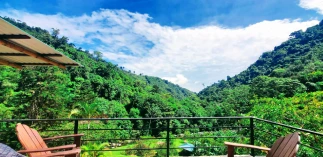While many associate Costa Rica with vibrant toucans and emerald quetzals, a smaller, yet equally stunning gem graces our mountain forests for a part of the year – the Black-throated Blue Warbler. This tiny songbird, a visitor from eastern North America, offers a breathtaking splash of color during its migration between breeding and wintering grounds.
A Tale of Two Plumages
The Black-throated Blue Warbler is a master of disguise, depending on its gender. Males are the stars of the show, boasting a dazzling uniform of deep blue across their backs and wings. This electrifying hue contrasts beautifully with their jet-black throat, face, and flanks, making them resemble miniature superheroes flitting through the undergrowth.
Females, on the other hand, take a more understated approach. Their plumage is a symphony of olive-brown above and light yellow below, with subtle hints of blue peeking through on their wings and tail. However, both sexes share a key identifying feature – a tiny white patch on their wing, sometimes likened to a pocket handkerchief.
A Life on the Move
Black-throated Blue Warblers are champions of long-distance travel. They breed in the cool interior forests of eastern North America, building their nests amongst dense vegetation. Come fall, when the days shorten and temperatures dip, these intrepid birds embark on a southward journey, with Costa Rica serving as a vital stopover point.
Here in our mountain sanctuary, surrounded by lush greenery, they find a haven to rest and refuel before continuing their trek to their wintering grounds in the Caribbean and Central America. Their stay is relatively brief, typically lasting from September to April, but their presence adds a touch of magic to our mountain trails.
A Master of Foraging
Black-throated Blue Warblers are meticulous insectivores. They flit through the understory, their sharp, pointed bills adept at extracting insects hidden amongst leaves and twigs. You might see them hovering for a moment, snatching a juicy caterpillar, or meticulously gleaning spiders from their webs. Their methodical foraging style, in contrast to the flitting movements of some warblers, makes them a delight to observe.
A Song Unsung (…Almost)
While the Black-throated Blue Warbler might not be the most flamboyant singer in the forest, it does possess a unique vocalization. Their song is described as a lazy, buzzy melody, often ending with a long, drawn-out note. Though not as complex as some warbler songs, it’s a charming addition to the morning chorus that fills our mountain sanctuary.
A Transient Treasure
The Black-throated Blue Warbler’s visit to our mountain retreat is a fleeting yet cherished event. Their presence reminds us of the interconnectedness of the natural world and the incredible journeys undertaken by these tiny feathered marvels. So, the next time you’re exploring our forest trails, keep an eye out for a flash of azure flitting amongst the leaves. You might just be lucky enough to catch a glimpse of this captivating migrant gracing our mountain paradise.
For more information, please view our comprehensive guide about the birds of Costa Rica







